
Yue is a branch of the Sinitic languages primarily spoken in Southern China, particularly in the provinces of Guangdong and Guangxi.

Min is a broad group of Sinitic languages with about 70 million native speakers. These languages are spoken in Fujian province as well as by the descendants of Min-speaking colonists on the Leizhou Peninsula and Hainan and by the assimilated natives of Chaoshan, parts of Zhongshan, three counties in southern Wenzhou, the Zhoushan archipelago, Taiwan and scattered in pockets or sporadically across Hong Kong, Macau, and several countries in Southeast Asia, particularly Singapore, Malaysia, the Philippines, Indonesia, Thailand, Myanmar, Cambodia, Vietnam, Brunei. The name is derived from the Min River in Fujian, which is also the abbreviated name of Fujian Province. Min varieties are not mutually intelligible with one another nor with any other variety of Chinese.

Southern Min, Minnan or Banlam, is a group of linguistically similar and historically related Chinese languages that form a branch of Min Chinese spoken in Fujian, most of Taiwan, Eastern Guangdong, Hainan, and Southern Zhejiang. Southern Min dialects are also spoken by descendants of emigrants from these areas in diaspora, most notably in Southeast Asia, such as Singapore, Malaysia, the Philippines, Indonesia, Brunei, Southern Thailand, Myanmar, Cambodia, Southern and Central Vietnam, San Francisco, Los Angeles and New York City. Minnan is the most widely-spoken branch of Min, with approximately 48 million speakers as of 2017–2018.

Zhongshan is a prefecture-level city in the south of the Pearl River Delta in Guangdong province, China. As of the 2020 census, the whole city with 4,418,060 inhabitants is now part of the Guangzhou–Shenzhen conurbation with 65,565,622 inhabitants. The city-core subdistricts used to be called Shiqi or Shekki.

There are hundreds of local Chinese language varieties forming a branch of the Sino-Tibetan language family, many of which are not mutually intelligible. Variation is particularly strong in the more mountainous southeast part of mainland China. The varieties are typically classified into several groups: Mandarin, Wu, Min, Xiang, Gan, Jin, Hakka and Yue, though some varieties remain unclassified. These groups are neither clades nor individual languages defined by mutual intelligibility, but reflect common phonological developments from Middle Chinese.
Manjiang, also known as Manhua, is an Eastern Min dialect spoken mainly in Taishun and Cangnan Counties in Wenzhou, as well as parts of Qingyuan County in Lishui, in southeastern Zhejiang province.

Eastern Min or Min Dong is a branch of the Min group of the Chinese languages of China. The prestige form and most commonly cited representative form is the Fuzhou dialect, the speech of the capital of Fujian.
Shaozhou Tuhua, also known as Yuebei Tuhua (粤北土话), is an unclassified Chinese variety spoken in northern Guangdong province, China. It is mutually unintelligible with Xiang, Cantonese, and Mandarin.
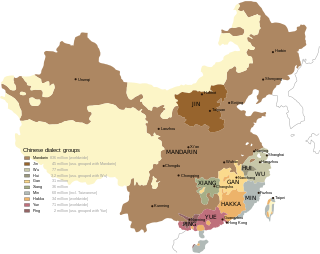
The Sinitic languages, often synonymous with the Chinese languages, are a group of East Asian analytic languages that constitute a major branch of the Sino-Tibetan language family. It is frequently proposed that there is a primary split between the Sinitic languages and the rest of the family. This view is rejected by some researchers but has found phylogenetic support among others. The Macro-Bai languages, whose classification is difficult, may be an offshoot of Old Chinese and thus Sinitic; otherwise, Sinitic is defined only by the many varieties of Chinese unified by a shared historical background, and usage of the term "Sinitic" may reflect the linguistic view that Chinese constitutes a family of distinct languages, rather than variants of a single language.

Central Min, or Min Zhong, is a part of the Min group of varieties of Chinese. It is spoken in the valley of the Sha River in Sanming prefecture in the central mountain areas of Fujian, consisting of Yong'an, the urban area of Sanming and Sha County.
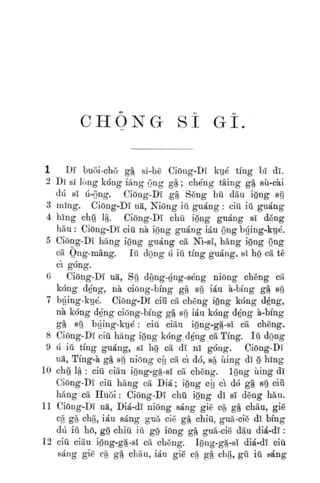
The Jian'ou dialect, also known as Kienow dialect, is a local dialect of Northern Min Chinese spoken in Jian'ou in northern Fujian province. It is regarded as the standard common language in Jian'ou.

Leizhou or LuichewMin is a branch of Min Chinese spoken in Leizhou city, Xuwen County, Mazhang District, most parts of Suixi County and also spoken inside of the linguistically diverse Xiashan District. In the classification of Yuan Jiahua, it was included in the Southern Min group, though it has low intelligibility with other Southern Min varieties. In the classification of Li Rong, used by the Language Atlas of China, it was treated as a separate Min subgroup. Hou Jingyi combined it with Hainanese in a Qiong–Lei group.
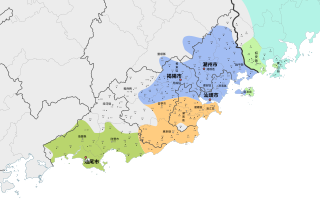
Hoklo, Hailufeng, or in the language itself Haklau, is a variety of Chinese mostly spoken in the Hailufeng region of Guangdong. The region includes Shanwei (Swabue), which administratively includes Haifeng County, and Lufeng City, which itself was a former county and now county-level city. The name 'Hailufeng' / 'Hai Lok Hong' (海陸丰) is a portmanteau of those places. It is a Southern Min language with similarities to Hokkien, especially Chiangchew Hokkien, though it also has close geographical and cultural ties with neighboring Teo-Swa. Ethnically, the Hoklo see themselves as Hailok, separate from the Teochews.
Zhongshan Min, known as Cunhua by its speakers, are three Min Chinese dialect islands in the Zhongshan region of the southern Chinese province of Guangdong. The Zhongshan Min people settled in the region from Fujian Province as early as the Northern Song dynasty period (1023–1031). The three dialects are:
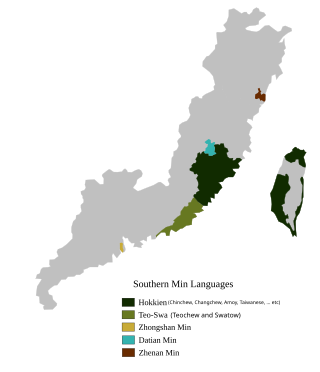
Zhenan Min, is a Min Nan Chinese language spoken in the vicinity of Wenzhou, in the southeast of Zhejiang province.

The Longyan dialect, also known as Longyan Minnan or Liong11l11334, is a dialect of Hokkien spoken in the urban city area of Eastern Longyan in the province of Fujian, China, while Hakka is spoken in rural villages of Western Longyan. The Longyan Min people had settled in the region from southern Fujian Province as early as the Tang dynasty (618–907). Due to its close proximity to rural Hakka villages, Longyan Min has some influence from Hakka albeit to a limited extent. The Longyan dialect has a limited degree of intelligibility with other Southern Min dialects. Today, Longyan Minnan is predominantly spoken in Longyan's urban district Xinluo District while Zhangzhou Minnan is spoken in Zhangping City excluding Chishui and Shuangyang towns where Longyan Minnan is spoken. Hakka on the other hand is spoken in the non-urban rest of the rural areas of Longyan prefecture: Changting County, Liancheng County, Shanghang County, Wuping County, and Yongding District.

The Zhanjiang dialect is a dialect mostly spoken in Zhanjiang in Guangdong, China. It is a sub-dialect of Leizhou Min.
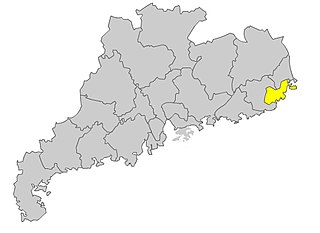
The Swatow dialect, or in Mandarin the Shantou dialect, is a Chinese dialect mostly spoken in Shantou in Guangdong, China. It is a dialect of Chaoshan Min language. It is similar to and largely mutually intelligible with the Teochew dialect.
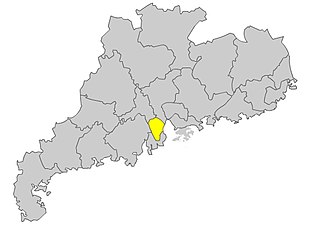
Sanxiang is a Min variety of either Southern Min or Eastern Min Chinese mostly spoken in Sanxiang in Zhongshan in the Pearl River Delta of Guangdong, China. Despite its close proximity, Sanxiang is not very closely related to the surrounding dialects in the region, which belong to the Yue group, and thus forms a "dialect island" of Min speakers. It is one of three enclaves of Min in Zhongshan, the others being Longdu and Nanlang.

The Nanlang dialect is a variety of Eastern Min Chinese mostly spoken in Nanlang in Zhongshan in the Pearl River Delta of Guangdong, China. Despite its close proximity, Nanlang is not very closely related to the surrounding dialects in the region, which belong to the Yue group. As such, Nanlang forms a "dialect island" of Min speakers. It is one of three enclaves of Min in Zhongshan, the others being Longdu and Sanxiang.













